Last weekend, the Coupe de France Féminine semi-finals took place with the Paris derby on Sunday. Saturday’s game between Lyon and Fleury was expected to be a routine victory for European giants Lyon. However, we would be wrong to assume anything.
This tactical analysis will explore the critical tactics involved in this victory. Although this analysis will first focus on the game, let’s provide some context to the two teams.
Lyon has been at the forefront of Women’s football for the last decade, winning a record sixteen of the last Division 1 Féminine titles. Alongside their national dominance, they have achieved similar levels of success on the European stage, winning a record eight Champions League titles, all coming since the 2010-11 season.
While Lyon has been dominant in France, Fleury has had a very different history, having formed in 2003 as FCF Val d’Orge. It was then rebranded as Fleury 91 in 2017, as a result of being promoted to Division 1 Féminine to attach themselves to the men’s side. With the appointment of Fabrice Abriel in 2021 Fleury has gone from strength to strength and established itself as the fourth-best team in France for the past two seasons and sits in fourth place again this season. This result is perhaps the biggest scalp of their relatively new history.
This match analysis will focus on the defensive tactics Abriel used to defeat one of Europe’s premier sides.
Lineups
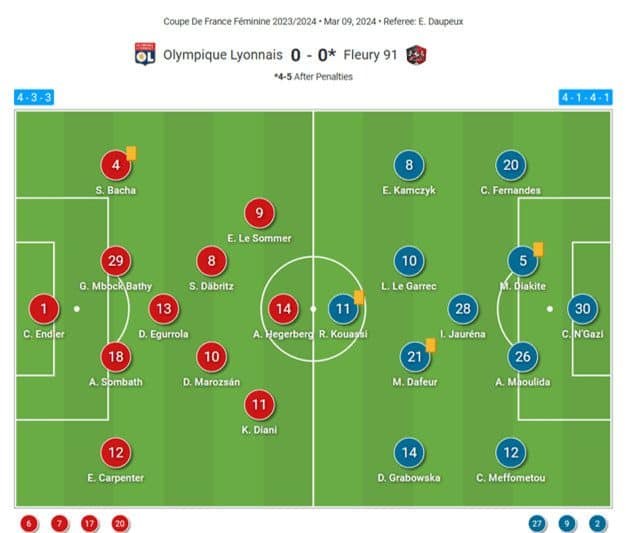
In this game, Lyon lined up in a 4-3-3 formation, which they have done for the majority of Sonia Bompastor’s reign.
Along the backline, the notable names missing were club captain and icon Wendie Renard, who is still recovering from an injury from 16th December, which she had to undergo surgery—in addition to Renard missing, Lyon also missed Canadian international Vanessa Gilles, who was still returning from CONCACAF Gold Cup. So, in the centre of the defence, they were forced to start Griedge Mbock Bathy alongside the young Alice Sombath, who has typically played as a full-back this season. At fullback, Lyon started with Australian international Ellie Carpenter on the right and France international Selma Bacha on the left.
In midfield, Lyon was without US international Lindsey Horan, who was leading her USWNT to Gold Cup glory over Brazil. However, despite missing Horan, Lyon still had high-calibre players who were experienced internationals. They started with Damaris Egurrola as the deep midfielder, and Sara Däbritz and Dzsenifer Marozsán played as the more advanced midfielders.
Then, to complete the team, they started with a front three of Eugénie Le Sommer on the left, Norwegian star Ada Hegerberg playing through the middle, and French international and summer signing Kadidiatou Diani starting on the right wing. However, after seventeen minutes, Hegerberg was forced off through an injury, and Amel Majri was brought on to play as the left winger, and Le Sommer was moved into the middle.
As you can see, despite a few injuries in the side, Lyon still had a wealth of experience on the field and more than enough quality to get the job done.
On the other hand, Fleury lined up in a 4-3-3 as well. This is consistent with how Fabrice Abriel has deployed his side throughout the season. The only variation is the midfield combination, with Abriel often playing with double pivots and a single attacking midfielder. However, against the big sides in the division, such as PSG, Lyon, and Paris FC, he has deployed either a deep midfielder screening the backline or a back five.
In this game, the backline consisted of Claudine Meffometou at left-back, Assimina Maoulida, and Mariam Diakite playing as the central defenders. Tiana Harris dropped out of the side following an injury she sustained the previous weekend against Reims. Then, to complete the backline, Charlotte Fernandes started at right back. The majority of the backline has played significant minutes with each other throughout the season.
In midfield, former Lyon player Inès Jauréna started as the deep midfielder, acting as a screen for the backline. In front of her were Marine Daffeur and Léa Le Garrec.
In the front line, Abriel deployed a front three of Polish internationals Dominika Grabowska on the left wing and Ewelina Kamczyk on the right wing. Kamczyk has typically played more centrally this season as a creative midfielder behind two deep midfielders. To complete the front line was young Costa Rican centre forward Rosemonde Kouassi, with Haiti international Batcheba Louis waiting in the wings to come on through the middle.
Disciplined Defensive display
Right from the start, Fleury’s game plan was clear. Lyon were allowed to have the ball for 67.87% of the game. With that, they were able to create an xG of 1.07 across the 14 shots they had during the game, averaging 0.08 xG per shot. The key to Fleury’s getting this result was their ability to eliminate high-quality Lyon chances throughout the game.
A significant contributor to this success was through their shape in the mid-low block. In these defensive phases, Fleury looked to compress the wide areas that Lyon looked to play in, limiting their options and being able to nip in to win the ball back and disrupt the rhythm of the Lyon attack. This ability to disrupt makes the dominant possession stats misleading, as Fleury were able to control Lyon in possession for large spells of the game.
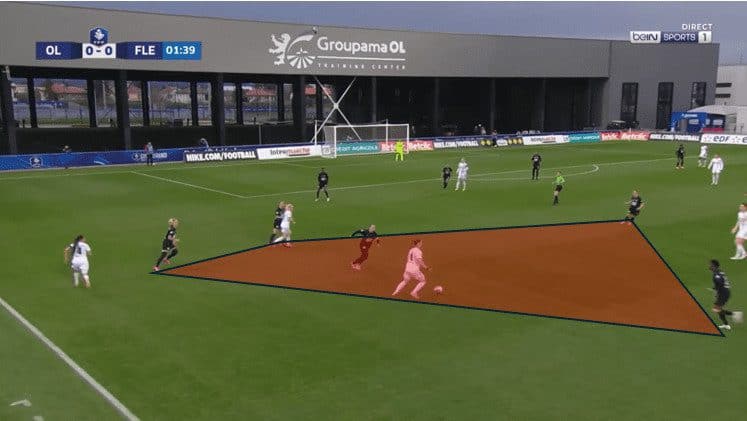
In this example, you can see how Fleury looks to compress the wide areas from all sides. With La Garrec, Fernandes, and Kamczyk all in the final third, they match up to the three Lyon players in the wide channel. While this is occurring, you have pressure from behind by Kouassi, who blocks that passing lane backwards, and then Daffeur is ready to put pressure on any ball across the field.
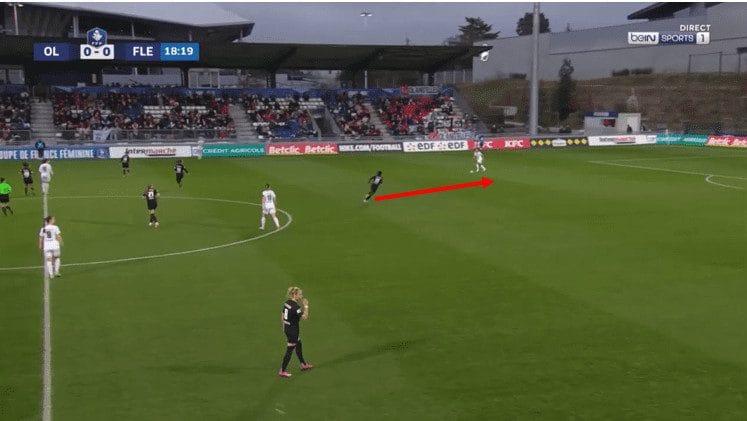
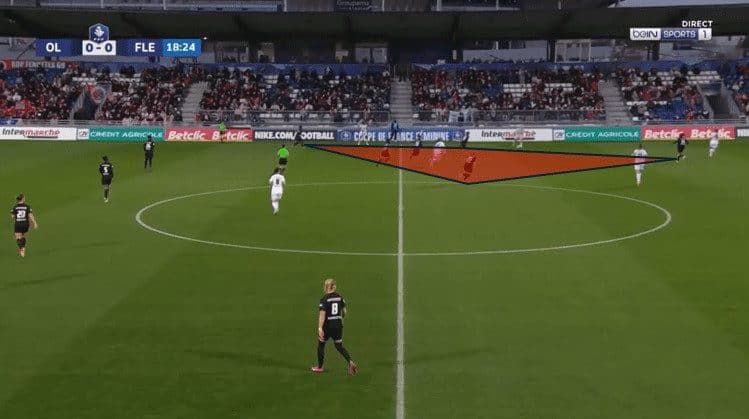
In this example, you can see how Fleury looks to manipulate the opposition in the mid-block. Kouassi stepped up and blocked the passing lane between centre-backs, forcing Lyon to play down the right side of attack. With the ball there, you can see seven Fleury players compressing the wide channel, which forces Lyon to go back and eventually play a long direct ball, which is picked up by the goalkeeper.
However, not only did Fleury compress the wide areas, making it difficult to play when balls were played into the box, but she also packed bodies centrally to limit spaces and opportunities in the box. With no free headers available, everything was challenged and competed with.
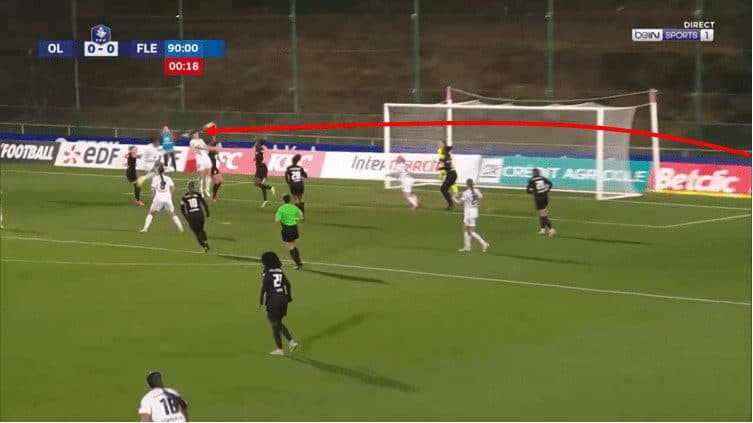
Here, Carpenter is able to win a one-on-one battle out wide and play a ball into the box, which is headed by Egurrola. However, look how the Fleury competes for the header and forces an awkward off-balance header. The ball eventually falls into the box towards Le Sommer; however, Fleury’s sheer number of bodies in the box enables them to clear the danger away.
In addition to this, a key attribute to Fleury’s success in the defensive phase is the role of Jauréna. She was key to filling the gaps centrally as Lyon looked to shift the ball from side to side and attack down the flanks. This provided time for her midfield teammates to work across the field and compress the opposite side of the field as well. In addition to this, her ability to block penetrating passes through the midfield was key to the side.
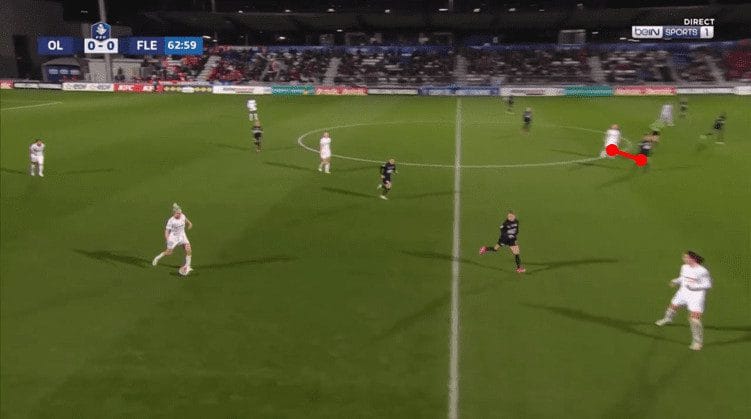
Here, you can see Jauréna marking this central player and thus blocking any penetrating passes through the midfield.
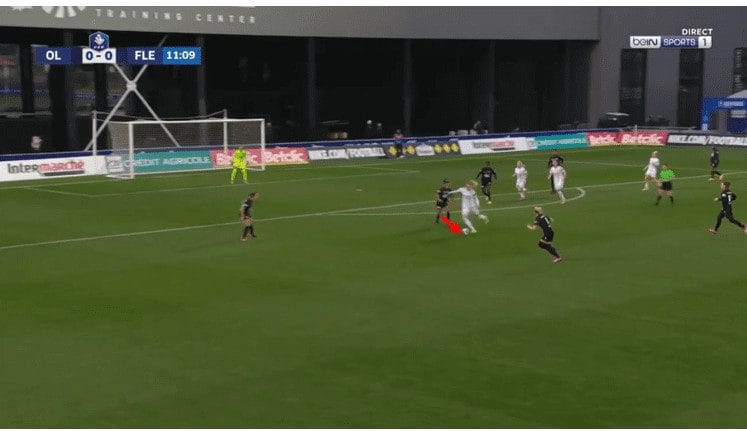
Here, you can see Le Sommer receiving the ball with her back to the goal. What you will see is the instant pressure from Jauréna, which prevents her from turning and driving towards the goal.
Lack of quality chances
Throughout the game, Lyon struggled to create significant chances from open play, with Fleury’s defensive shape resolute throughout. This forced Lyon into low-percentage shots, either outside the box or from awkward angles, which they were unable to convert.
However, despite struggling to create many chances, they did look more dangerous in the second half when they were able to shift the ball quickly from the backline to the front line. With the Fleury shape remaining compact, they could be drawn forward in deeper build-up possession.
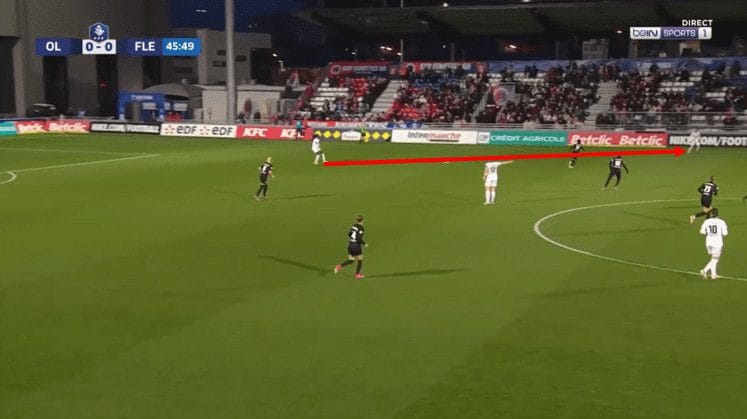
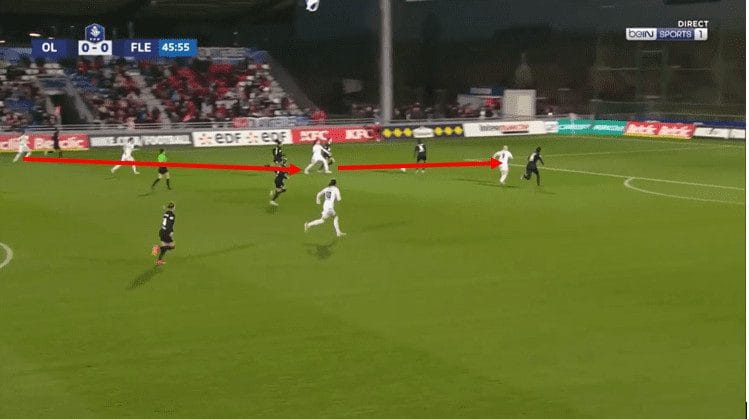
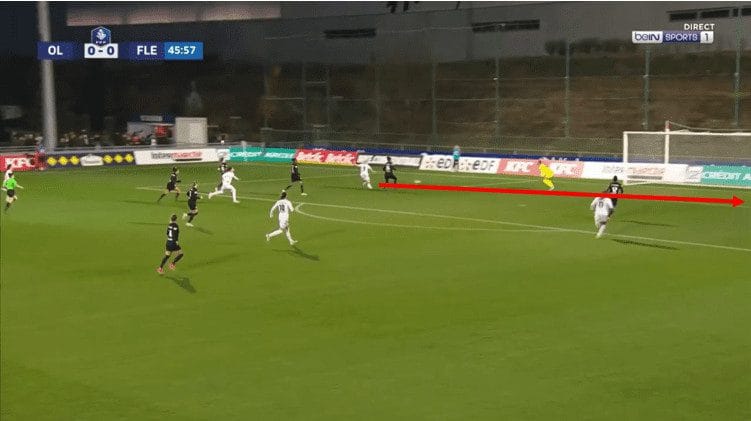
In this example, Lyon is able to pass around the Fleury shape down the left flank, where they get the ball into Majri, who draws the central defender’s attention and enables Le Sommer to get in behind and get a shot on goal.
However, note the position of the shot. The left central defender, Maoulida, tracks Le Sommer, forcing her to hit it from a wide position at a difficult angle, which makes it difficult for the shot to go wide.
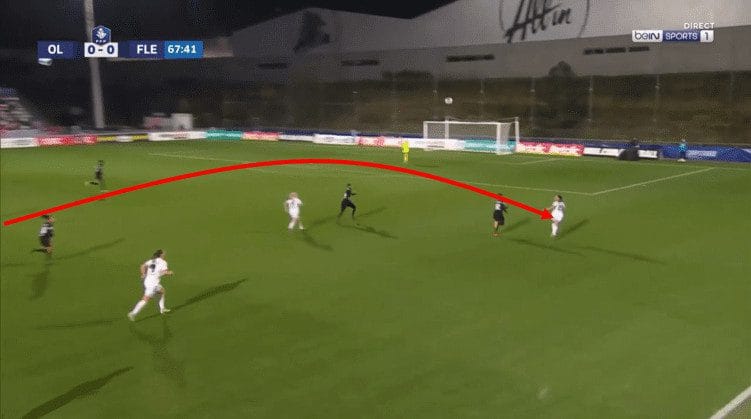
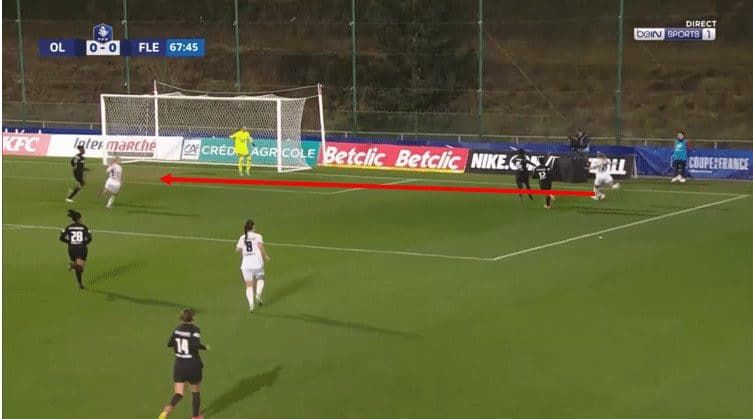
In this example, Lyon plays a long ball forward towards substitute Cascarino. Cascarino is then able to create space for a cross into the box, and she tries to whip it behind the defensive line low on the ground. Ideally, however, you would have somebody attacking this space on the near post so they could flick the ball goalwards.
With Lyon getting frustrated and Fleury sitting back, the game was there for somebody to win, but Fleury struggled to create anything on the counterattack. Starting with Douassi as the lone striker looking to use her speed to get in behind the backline, she struggled to get any quality ball.
So Abriel switched Douassi and Kamczyk around. With the thought process, Douassi could pick the ball up and carry the ball forward out of a defence-attack transition. While Kamczyk, typically a midfielder, could use her technical skills to receive the ball to feet and hold the ball up in attack.
However, this change did provide some respite to the defence and enabled Fleury to move the territory game. They struggled to create any actual goal-mouth action, only achieving an xG of 0.06, with these forwards becoming isolated and having limited options for which to aim.
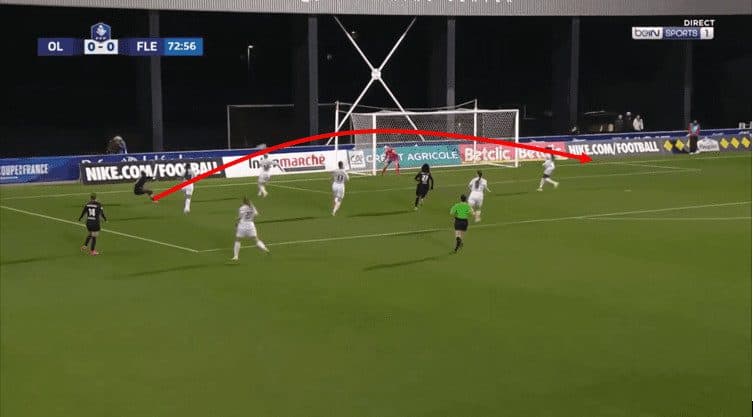
Here, you can see Fleury has gone onto the attack having won the ball back. However, you can see the limited options in the box, with nobody to aim for other than a late run by Louis. The good field position comes to nothing, with the rest of the team remaining back ready for the next Lyon attack.
With neither team able to create quality chances, the game ultimately went to penalties. What was interesting was how Fleury had clearly identified a strategy, with six of their seven penalties going to the left side of the goal, including the two that were missed.
Lyon’s approach was much more varied, using both sides of the goal. However, interestingly, Fleury goalkeeper Chloé N’Gazi went the correct direction on the first three penalties, with one missed, one saved, and one going in off the post.
It appeared that Fleury was more prepared for a penalty shootout and had a clear plan of action, which translated into a victory.
Conclusion
Looking at this result and the surface-level stats, you may well just say that this was a so-called ‘smash and grab’ result. However, Abriel’s side came in with a clear game plan to frustrate Lyon, and that clarity and discipline demonstrated throughout the side was what got the game to penalties. Then, in penalties, Fleury clearly had a game plan that proved successful in one of football’s great oddities.
On the other hand, Lyon could chalk this up to missing several key players; however, this is more than just a solo outlier, with some draws against PSG, Brann and Slavia Praha, where opponents have been able to frustrate Lyon. However, despite this, Lyon certainly has the quality of player to bounce back, and it still remains seven points clear at the top of the table and in the knockout stages of the Champions League.






Comments